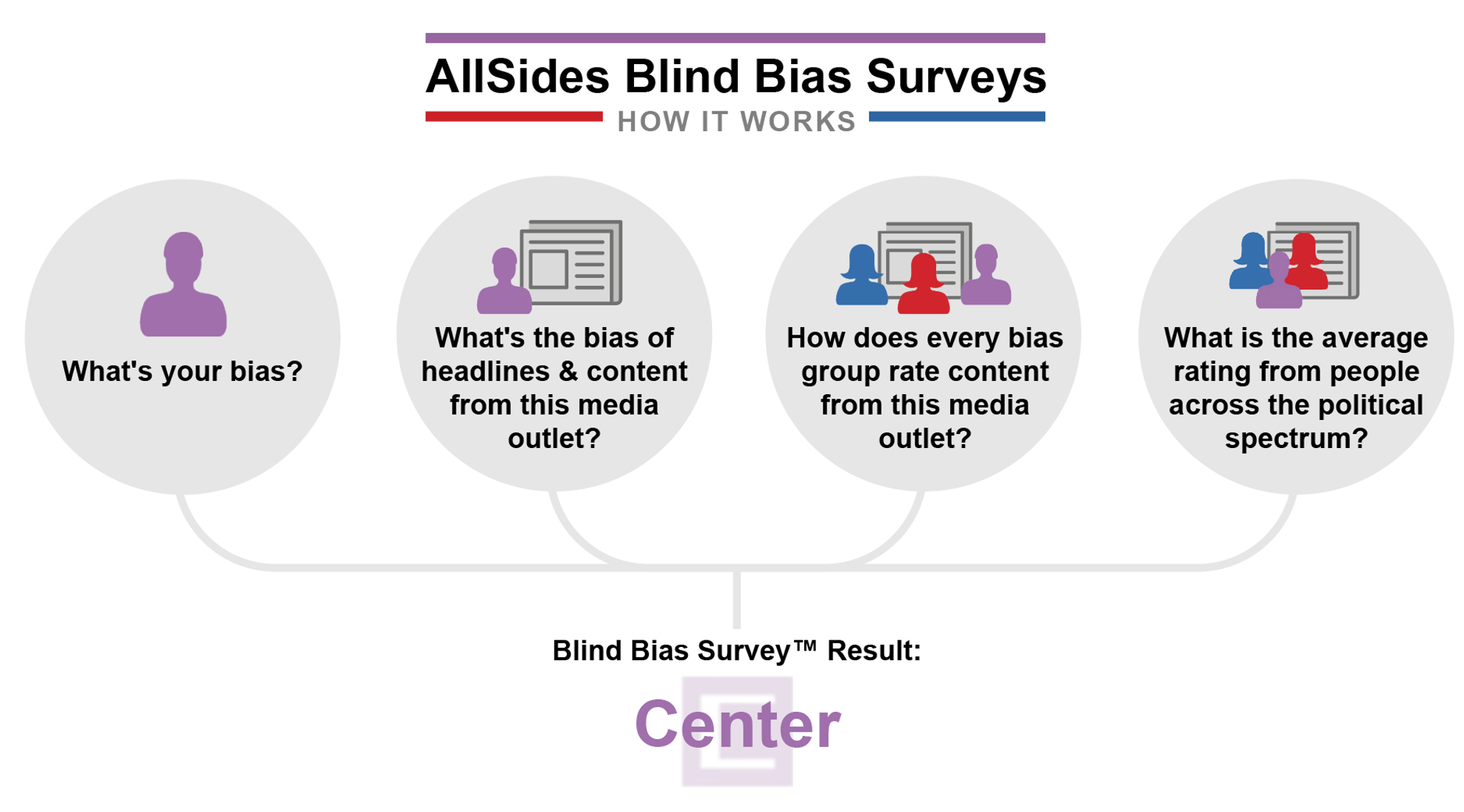AllSides conducted research into the perceived bias of five major media outlets in August 2023. Of the five, MSNBC, The Post Millennial, Vox, and The Wall Street Journal appear on the AllSides Media Bias Chart™.
During an AllSides Blind Bias Survey, participants from all sides of the political spectrum are asked to rate the content of a media outlet blindly, so they are not influenced by preconceived notions of a brand's bias. Read the white paper to review our methodology, or sign up to take part in the next survey.
Survey Results

AllSides Rated Center
AllSides was rated Center (0.4) by respondents across the political spectrum.
AllSides was rated Center on average across all bias groups - Democrats, Independents, and Republicans, as well as among those who rate their own bias as Left, Lean Left, Center, Lean Right, or Right. The result matched AllSides' Balance Certification™ criteria for Blind Bias Survey results. A total of 735 participants rated AllSides.
AllSides rates itself as having a Mixed bias, a designation we give to outlets that specifically curate diverse perspectives.

MSNBC Rated Left
MSNBC was rated Left (-5.67) on average. A total of 691 people rated MSNBC.
MSNBC was rated Left on average across all bias groups - Democrats, Independents, and Republicans, as well as among those who rate their own bias as Left, Lean Left, Center, Lean Right, or Right.
The Post Millennial Rated Right
AllSides moved The Post Millennial's bias rating from Lean Right to Right after 711 respondents rated the outlet as Right (4.65) on average.
Respondents who rated their own personal bias as Left, Lean Left, Center, or Lean Right rated TPM as Right. Respondents with a Right bias rated it Lean Right. On average, Democrats, Independents, and Republicans all rated The Post Millennial as Right on average.
Vox Rated Left
Vox was rated Left (-3.49) on average. A total of 698 people rated Vox.
Respondents across all bias groups rated Vox as Left on average, with the exception of those who rated their own bias as Lean Left or who identified as Democrats; these groups on average rated Vox as Lean Left.

The Wall Street Journal Rated Lean Left; AllSides Keeps Center Rating
The Wall Street Journal was rated Lean Left (-2.76). A total of 792 people rated WSJ. AllSides conducted an Editorial Review and opted to keep WSJ's bias rating as Center.
Respondents who rated their own bias as Left, Lean Left, Center, and Right rated WSJ as Lean Left; respondents with a Lean Right bias rated it Left. Republicans rated WSJ as Left; Democrats and Indpendents rated it Lean Left.

About The Survey
A total of 1,181 people across the political spectrum took the survey, including 132 respondents with a self-reported Left bias; 259 with a Lean Left bias; 354 with a Center bias; 343 with a Lean Right bias, and 93 with a Right bias.
Respondents self-reported party affiliation. 252 respondents were Democrats, 535 were Independents, 256 were Republicans.
Results are not assessed by majority rule; we calculate pluralities and averages, both within respondent groups and across all respondent groups, to arrive at final determinations.
For this survey, AllSides collected 10 pieces of content from media outlets: top headlines taken on two different days at the same time of day, and top stories the outlet ran around two major national news stories. Stories and headlines were stripped of branding and any information that would allow participants to identify the outlet. Participants were asked to rate the bias of the source on a scale of Left, Lean Left, Center, Lean Right, and Right.
Results are represented on a scale of -9 to +9, with 0 representing dead Center, -9 representing Left and +9 representing Right:
Left: -9.00 to -3.00
Lean Left: -2.99 to -1.00
Center: -0.99 to +0.99
Lean Right: +1.00 to +2.99
Right: +3.00 to +9.00
Note About Blind Bias Surveys
Blind surveys are robust, but do have limitations. They alone do not always determine our ratings. These surveys ask respondents to assess a relatively small snapshot of the source's content in time. The surveys don't include photos, content published over a long period of time, or other crucial elements for determining bias. Therefore, we often use blind survey data in conjunction with other methods to arrive at a final bias rating, such as Editorial Reviews, third party data and independent reviews by AllSides reviewers.
AllSides uses multiple methods for calculating media bias ratings.
Our Blind Bias Survey, described in the graphic below, represents one of our most robust media bias rating methods, but it is not the only method we use. A source might openly share its bias, or it may be determined by third party research, an independent review, or an Editorial Review. Take a look at the multiple methods AllSides uses to measure and rate media bias.




